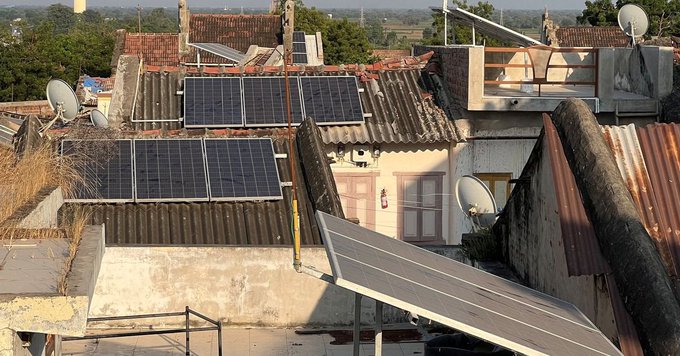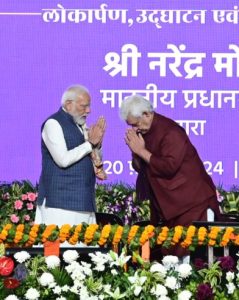Solar energy powers new green revolution

By Satyajeet
New Delhi, November 4: The recent report of Intergovernmental Panel on Climate Change (IPCC-UNO) confirmed that two degree celsius rise in global temperature is now a certainty. It means, henceforth, intense summers are inevitable across the globe, because of the ‘Global Warming’. Depletion of ozone is held responsible for rise in temperature but deforestation, humongous usage of fossil fuels and subsequently, the CO2 emission are the main culprits.
But nevertheless, we are doing it and the reason is our ‘energy’ requirements. But, we can never stop the Sun only because the ozone is depleting and globe is warming. Still, we can convert this ‘crisis’ in ‘opportunity’ and the foremost solution is – ‘Solar Energy’!
Considering the pace of demand of energy globally and futuristic approach, utilization of solar energy at just domestic level is insufficient and minima qauntitas. Apart from the domestic sector and the ‘industry’, the utilization of solar energy has the potential to be explored on huge scale and a potential sector is – ‘Agriculture’! In case of India, being a tropical country that attracts abnormal temperature not less than 18 degree celsius annually, it has realized this ‘blessing in disguise’ way back in 2019 when the Union government under Prime Minister Narendra Modi had approved the launch of ‘Pradhan Mantri Kisan Urja Suraksha Evam Uttaan Mahabhiyaan Yojana (PM KUSUM Scheme)’.
Agriculture sector of the country consumes 20 per cent of the electricity (power) and is third highest after industry and household sector. Moreover, being an agriculture-based country, agriculture sector provides livelihood to two-thirds of the total working population and contributes to 15 per cent of the Gross Domestic Product (GDP). Tallying these accounts of India’s agriculture, it can gradually but certainly play a vital role in harvesting the ‘solar energy’.
Under the scheme, the Union government has been proactively undertaking various steps to tap this opportunity. The scheme has the objective of installing 10,000 MW of Decentralized Ground Mounted Grid Connected Solar Power Plants, installation of 20 lakh standalone Solar Powered Agriculture Pumps and Solarisation of 15 Lakh Grid-connected Agriculture Pumps including through Feeder Level Solarisation. Till September 2022, under PM KUSUM Scheme, 1,47,367 solar powered pumps have been installed, 23,91,829 feeder level solar installations are sanctioned and installation of decentralized grid connected solar power plants of capacity 4,886 MW is at different stages of progress.
The scheme is one of largest initiatives in the world to provide clean energy to more than 35 lakh farmers by solarizing their agriculture pump. The scheme also has direct employment generation potential. Around 24.50 job-years are created per MW of small capacity solar installation. Therefore, besides increasing self-employment, the scheme is likely to generate employment opportunities equivalent to 7.55 lakh job-years for skilled and unskilled workers.
Moreover, power generated from solar plants is being purchased by the Distribution companies (DISCOMs) at tariffs determined by the respective State Electricity Regulatory Commissions (SERCs). Also, the solar plant can be installed by the farmer or he can provide his land on lease to a developer, who will install the plant. Hence, the new concept of ‘solar harvesting’ is emerging under which even the barren land is being utilized by millions of farmers across the country. The scheme has opened a stable and continuous source of income for the rural land owners. It has been estimated that farmers are earning up to Rs. 25,000 per acre per year if the plant is installed by a developer on the land leased by the farmer, and up to Rs. 65,000 per acre per year if they install the plant themselves by taking loan from the banks. The Reserve Bank of India also included this component under priority sector lending and therefore, banks are providing loans at competitive rates and on soft terms.
Optimum and economic utilization of the solar power under PM KUSUM is bringing manifold benefits to the farmers and the governments like day-time reliable power for irrigation, replacing diesel pumps with solar pumps, reducing the burden of subsidy on agriculture electricity on States and improving the financial health of DISCOMS. Furthermore, nearly 80 lakh pumps out of 3 crore agricultural pumps installed in India are diesel pumps. The total diesel consumption of these pumps in a year works out to 5.52 billion litre along with equivalent CO2 emission of 15.4 million tonnes. When implemented fully, PM-KUSUM will lead to reducing carbon emissions by as much as 32 million tonnes of CO2 per annum. Farmers whose diesel pumps are replaced will be able to work on their farms in a pollution free environment.
On the global front, India has already heralded the sustainable use of solar energy. India founded the ‘International Solar Alliance (ISA)’ which is now the recognized body of United Nation Organization comprising 109 member and signatory countries. India’s roadmap in this regard is guided by the principle of ‘One Sun, One World, One Grid’ put forth by Prime Minister Narendra Modi in 2018 at the First Assembly of ISA. In December 2021, India has achieved its Nationally Determined Contributions (NDCs) target with total non-fossil based installed energy capacity of 157.32 GW which is 40.1% of the total installed electricity capacity. The share of solar energy is 48.55 GW; a 30.87% which is noteworthy.
It has rightly been said that in Surya Upanishad, सूर्याद् भवन्ति भूतानि, सूर्येण पालितानि तु॥ (Suryaad bhavanti bhutani, suryen palitani tu) which means everything has originated from the Sun, the source of all energy is the Sun, and everything is sustained by the energy of the Sun. Ever since life originated on Earth, the life cycle of all living beings, and their routine, has been linked to the sunrise and sunset. As long as this natural connect has continued, our planet remained healthy. In this modern era, we have to utilize this solar energy to tackle the global climate change and its use in agriculture will yield the sustainable outcomes which is the urgent need of the time.
(Author is a Junior Research Fellow, PPRC New Delhi)







